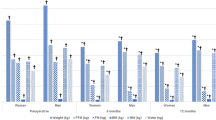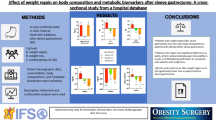Abstract
Background/Aim
Little data is available on body composition and biochemical parameter changes after one anastomosis gastric bypass (OAGB) surgery. This study was therefore conducted to assess body composition and biochemical parameter changes in patients who underwent OAGB. The relationship between the percentage of total weight loss (%TWL) with percentage changes in body composition and biochemical parameters was measured in the first year after surgery.
Materials and Methods
This retrospective study was carried out on 363 patients (mean age 39.93 ± 9.98 years) who underwent OAGB between January 2011 and November 2018. Anthropometric, body composition and biochemical measurements were recorded before and 1 year after surgery. For paired data, a paired sample t test or Wilcoxon test was used. Spearman or Pearson correlation test was used to evaluate the relationship between % TWL and changes in body composition and biochemical parameters.
Results
The average %TWL at 1 year following surgery was 35.72 ± 6.85. Fat and muscle tissue and also serum levels of glycemic parameters, low density lipoprotein, triglycerides (TG), total cholesterol, zinc, albumin, hemoglobin, hematocrit, and platelet had decreased a year after OAGB (P < 0.05). The postoperative levels of HDL-c, vitamins D, B12, and folic acid were dramatically higher than the preoperative values. Higher %TWL significantly correlated to greater decreases in body fat, muscle mass, and serum TG at 1 year post-surgery, compared to preoperative values.
Conclusion
OAGB may be effective over a follow-up period of 1 year in achieving weight, fat mass reduction, and improved serum levels of glycemic parameters and lipid profiles.
Similar content being viewed by others
References
Carbajo MA, Fong-Hirales A, Luque-de-Leon E, et al. Weight loss and improvement of lipid profiles in morbidly obese patients after laparoscopic one-anastomosis gastric bypass: 2-year follow-up. Surg Endosc. 2017;31(1):416–21.
Lee WJ, Wang W, Lee YC, et al. Effect of laparoscopic mini-gastric bypass for type 2 diabetes mellitus: comparison of BMI>35 and <35 kg/m2. J Gastrointest Surg. 2008;12(5):945–52.
Arble DM, Evers SS, Bozadjieva N, et al. Metabolic comparison of one-anastomosis gastric bypass, single-anastomosis duodenal-switch, Roux-en-Y gastric bypass, and vertical sleeve gastrectomy in rat. Surg Obes Relat Dis. 2018;14(12):1857–67.
Solouki A, Kermansaravi M, Davarpanah Jazi AH, et al. One-anastomosis gastric bypass as an alternative procedure of choice in morbidly obese patients. J Res Med Sci. 2018;23:84.
Lee WJ, Ser KH, Lee YC, et al. Laparoscopic Roux-en-Y vs. mini-gastric bypass for the treatment of morbid obesity: a 10-year experience. Obes Surg. 2012;22(12):1827–34.
Plamper A, Lingohr P, Nadal J, et al. Comparison of mini-gastric bypass with sleeve gastrectomy in a mainly super-obese patient group: first results. Surg Endosc. 2017;31:1156–62.
Vaurs C, Dimeglio C, Charras L, et al. Determinants of changes in muscle mass after bariatric surgery. Diabetes Metab. 2015;41(5):416–21.
Garciacaballero M, Reyes-Ortiz A, García Sillero M, et al. Changes of body composition in patients with BMI 23-50 after tailored one anastomosis gastric bypass (BAGUA): influence of diabetes and metabolic syndrome. Obes Surg. 2014;24(12):2040–7.
Rutledge R, Walsh TR. Continued excellent results with the mini-gastric bypass: six-year study in 2,410 patients. Obes Surg. 2005;15(9):1304–8.
Khalaj A, Kalantar Motamedi MA, Mousapour P, et al. Protein-calorie malnutrition requiring revisional surgery after one-anastomosis-mini-gastric bypass (OAGB-MGB): case series from the Tehran Obesity Treatment Study (TOTS). Obes Surg. 2019;29(6):1714–20.
Kessler Y, Adelson D, Mardy-Tilbor L, Ben-Porat T, Szold A, Goitein D, et al. Nutritional status following one anastomosis gastric bypass. Clin Nutr. 2019.
van Rutte P, Aarts E, Smulders J, Nienhuijs S. Nutrient deficiencies before and after sleeve gastrectomy. Obes Surg. 2014;24.
Arias PM, Domeniconi EA, Garcia M, et al. Micronutrient deficiencies after Roux-en-Y gastric bypass: long-term results. Obes Surg. 2020;30(1):169–73.
Milone M, Lupoli R, Maietta P, et al. Lipid profile changes in patients undergoing bariatric surgery: a comparative study between sleeve gastrectomy and mini-gastric bypass. Int J Surg. 2015;14:28–32.
Bagheri M, Talebpour M, Sharifi A, et al. Lipid profile change after bariatric surgeries: laparoscopic gastric plication versus mini gastric bypass. Acta Chir Belg. 2018;119:1–6.
Zamaninour N, Ansar H, Pazouki A, et al. Relationship between modified body adiposity index and A body shape index with biochemical parameters in bariatric surgery candidates. Obes Surg. 2020;30(3):901–9.
Ansar H, Zamaninour N, Pazouki A, et al. Weight loss after one anastomosis gastric bypass-mini gastric bypass (OAGB-MGB): patient-related perioperative predictive factors. Obes Surg. 2019;30(4):1316–23.
Carbajo MA, Jimenez JM, Luque-de-Leon E, et al. Evaluation of weight loss indicators and laparoscopic one-anastomosis gastric bypass outcomes. Sci Rep. 2018;8(1):1961.
Abdeen G, le Roux CW. Mechanism underlying the weight loss and complications of Roux-en-Y gastric bypass. Review. Obes Surg. 2016;26(2):410–21.
Koopman R, Ly CH, Ryall JG. A metabolic link to skeletal muscle wasting and regeneration. Front Physiol. 2014;5:32.
Marks BL, Rippe JM. The importance of fat free mass maintenance in weight loss programmes. Sports Med. 1996;22(5):273–81.
Cava E, Yeat NC, Mittendorfer B. Preserving healthy muscle during weight loss. Adv Nutr. 2017;8(3):511–9.
Angrisani L, Vitiello A, Hasani A, et al. Endpoint of bariatric surgery is not only preservation of free fat mass but restoration of normal body composition. Obes Surg. 2017;27(6):1633–4.
Maïmoun L, Lefebvre P, Aouinti S, et al. Acute and longer-term body composition changes after bariatric surgery. Surg Obes Relat Dis. 2019;15(11):1965–73.
Palacio A, Quintiliano D, Lira I, et al. Changes in body composition in patients following bariatric surgery: gastric bypass and sleeve gastrectomy. Nutr Hosp. 2019;36(2):334–49.
Omar W, Elhoofy A, Abdelbaky M. Bariatric surgery and its role in the management of metabolic syndrome. Egypt J Surg. 2019;38(2):257–66.
Heffron SP, Parikh A, Volodarskiy A, et al. Changes in lipid profile of obese patients following contemporary bariatric surgery: a meta-analysis. Am J Med. 2016;129(9):952–9.
Penney NC, Kinross J, Newton RC, et al. The role of bile acids in reducing the metabolic complications of obesity after bariatric surgery: a systematic commenw. Int J Obes. 2015;39(11):1565–74.
Laferrère B, Pattou F. Weight-independent mechanisms of glucose control after Roux-en-Y gastric bypass. Front Endocrinol (Lausanne). 2018;9:530.
Shankar P, Boylan M, Sriram K. Micronutrient deficiencies after bariatric surgery. Nutrition (Burbank, Los Angeles County, Calif). 2010;26(11–12):1031–7.
Lupoli R, Lembo E, Saldalamacchia G, et al. Bariatric surgery and long-term nutritional issues. World J Diabetes. 2017;8(11):464–74.
Aaseth E, Fagerland MW, Aas AM, et al. Vitamin concentrations 5 years after gastric bypass. Eur J Clin Nutr. 2015;69(11):1249–55.
Kermansaravi M, Abdolhosseini MR, Kabir A, et al. Severe hypoalbuminemia and steatohepatitis leading to death in a young vegetarian female, 8 months after mini gastric bypass: a case report. Int J Surg Case Rep. 2017;31:17–9.
Motamedi MAK, Barzin M, Ebrahimi M, et al. Severe fatal protein malnutrition and liver failure in a morbidly obese patient after mini-gastric bypass surgery: case report. Int J Surg Case Rep. 2017;33:71–4.
Chen M, Krishnamurthy A, Mohamed AR, et al. Hematological disorders following gastric bypass surgery: emerging concepts of the interplay between nutritional deficiency and inflammation. Biomed Res Int. 2013;2013:205467.
Johansson H-E, Wåhlén A, Aldenbäck E, et al. Platelet counts and liver enzymes after gastric bypass surgery. Obes Surg. 2018;28(6):1526–31.
Acknowledgments
The authors extend their sincere thanks to all participants and National Obesity Surgery Database team, who prepared us very useful data.
Funding
The authors received no financial support for the research, authorship, and/or publication of this article.
Author information
Authors and Affiliations
Corresponding author
Ethics declarations
Conflict of Interest
The authors declare that they have no conflict of interest.
Ethics and Consent
This study was conducted in accordance with the Helsinki declaration and approved by the Research Ethics committee (Ethics number: IR.IUMS.REC 1395.95-03-140-28809). Written informed consent form was received from all patients at the time of first registry in our database for any possible anonymous usage from their data.
Informed Consent
Written informed consent form was received from all patients at the time of first registry in our database for any possible anonymous usage from their data.
Additional information
Publisher’s Note
Springer Nature remains neutral with regard to jurisdictional claims in published maps and institutional affiliations.
Rights and permissions
About this article
Cite this article
Zamaninour, N., Pazouki, A., Kermansaravi, M. et al. Changes in Body Composition and Biochemical Parameters Following Laparoscopic One Anastomosis Gastric Bypass: 1-Year Follow-Up. OBES SURG 31, 232–238 (2021). https://doi.org/10.1007/s11695-020-04901-w
Received:
Revised:
Accepted:
Published:
Issue Date:
DOI: https://doi.org/10.1007/s11695-020-04901-w




